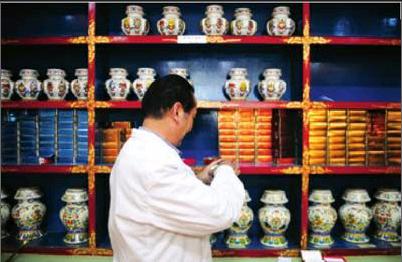Healing Forces
2014-02-10ByPanXiaoqiao
By+Pan+Xiaoqiao

Every summer, Tso-Ngon Tibetan Medicine Hospital in Xining, capital of northwest Chinas Qinghai Province, arranges for experienced doctors to conduct checkups in and outside the province. They usually open temporary medical camps at places used for religious ceremonies and gatherings by the areas ethnic Tibetan people. Local residents form long queues as they wait for their medical diagnosis and treatment. In remote or poor areas, the doctors services are free of charge.
As one of Chinas leading Tibetan medicine hospitals, Tso-Ngon Hospital always tries to make full use of the traditional Tibetan medication at its disposal. Currently, 80 percent of its clinical treatments use Tibetan herbs and medicine, while in external therapy Tibetan medicine is used in every sector.
A central reason for the hospitals popularity is that its medicines are effective and much cheaper than those sold in ordinary drugstores.
“The hospital is now able to process medical materials by itself. The herbs are mostly locally produced and quite cheap,” said Otsang Tsokchen, the hospitals director.
Jewel of tradition
Tibetan medicine has been around for more than 2,000 years. It first began to prosper in the seventh century on the Qinghai-Tibetan Plateau. With the great healing effects it has over many serious diseases, its winning over more and more people across the country.
Tibetan medicine is rich in medical classics. The Somaratsa, dating back to the early eighth century, is the earliest Tibetan medicine masterpiece that has been discovered to date, recording 440 kinds of medicine, of which over 300 can only be found on the Qinghai-Tibetan Plateau. Most of them are still used today.
The most well-known masterpiece of Tibetan medicine is Four Classic Medical Books of Traditional Tibetan Medicine, authored by Yuan Dan Kampo (708-835), the founder of Tibetan medicines theoretical system. The book covers 1,002 kinds of medicine and 400 prescriptions. Its existence shows that the system of Tibetan medicine had begun to take shape around that time.
In Tibetan medicine, it is believed that the relationship between a disease and symptoms is like that between fire and smoke. This understanding means that, while dealing with diseases. Tibetan medicine tends to regard the patient as a whole and tries to eradicate the roots of the disease instead of just removing symptoms. As an ancient medical system, Tibetan medicine has many unique features. For example, it pays a lot more attention to urine diagnosis compared to other medical systems.endprint
Under Tibetan medicine, treatment is divided into oral medication and external therapy.
In terms of oral medication, the principle is“to warm the cold and to chill the heat,” so as to reach a balance within a persons body. External therapy includes treatments such as pricking blood and steaming therapy.
A Tibetan medicine is commonly a mixture of 50 or even more medicinal herbs. More than 1,400 kinds of medicinal herbs are regularly used as ingredients, with a number of them found only on the Qinghai-Tibet Plateau.
The uniqueness of Tibetan medicine is best shown in its effectiveness at coping with nervous and immune system diseases. For example, rheumatic diseases are diagnosed by Tibetan medicine as problems in the immune system. When it comes to Western medicine,the only available treatment is painkillers and anti-inflammatories, while traditional Chinese medicine also finds rheumatic diseases difficult to deal with. “However, Tibetan medicine does a good job of treating this disease,”Otsang Tsokchen commented.
According to Wan Matai, Director of the Cardiovascular Department at Tso-Ngon Hospital, in 2011 the hospital received a patient from southwest Chinas Sichuan Province. The patient, who was in his 50s, was diagnosed with Guillain-Barré syndrome, which occurs when the immune system attacks the peripheral nervous system, leading to a weakness or tingling in the legs that moves up toward the torso. Before coming to the hospital, he had visited doctors at many prestigious hospitals in Sichuan, Beijing and Shanghai. However, Western medicine had ultimately failed him.
“Upon his arrival, he could not move his limbs. Eating and drinking was very difficult for him. After two weeks treatment in our department, during which he was fed with traditional Tibetan medicine such as pearl pills, coupled with acupuncture, grease ointments and pricking blood therapy, the patient was able to move. Two months later, when he left the hospital, he was able to walk by himself,” said Wan.
Buddhist connections
Kunchok Gyaltsen is a professor and Ph.D supervisor at Qinghai Universitys Tibetan Medicine College. Different from most teachers at the college, he is a lama, and is now honorary president of Kumbum Tibetan Medicine Hospital, which was set up in 1980 in the Tar Monastery in Xining. The Tar Monastery has its own medical institute that trains monk doctors.endprint
